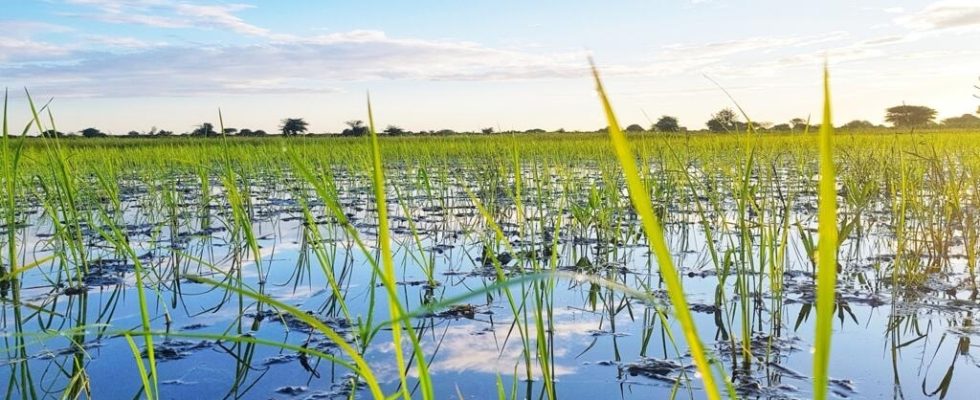In Tanzania, a disease is ravaging rice crops. An epidemic that is gaining momentum, about 20% of the country’s rice fields would be affected according to the Tanzanian agricultural research institute. According to publications by international researchers, it could be caused by seed tests carried out during collaborations between Chinese and Tanzanian agricultural researchers.
Some are already calling it the “Covid” of rice. This Xoo bacterium (Xanthomonas oryzae pathovar oryzae) enters the leaves, attacks the plant and dries it out. Thus, the grain of rice does not fill, which has consequences on yields. A fifth of production would be affected according to several Tanzanian experts contacted. “ The producers we met in the field tell us that last year they had twice as many bags of rice per plot as this yearexplains Boris Szurek, phyto-pathologist at the IRD, the Research Institute for Development in France who has just returned fromepidemic surveillance work in Tanzania, Ten years ago when we came to the same land, there was absolutely nothing about this bacteriosis. However, this year, there is an explosion of the epidemic, it is very worrying “.
The seeds carrying the disease?
These bacterial burns were observed in Morogoro, the main rice-growing region, but also in the regions of Muenza and Arusha. Scientists have even spotted the disease near Mombassa in Kenya. The epidemic is spreading, and it is affecting a very large part of the fields, according to Ibrahim Hashim of the Tanzanian agricultural research institute: In all areas where there is irrigation, half of the fields are affected. The challenge is to supply these regions with healthy seeds, because my fear is that if farmers continue to receive the seeds that carry the bacteria, the problem will persist for a very long time. “.
Ongoing investigations to find the origin of this epidemic, say the authorities. The seeds could themselves be vectors of bacteria, which would explain the dissemination over such great distances. Research is carried out in particular at the IRD. What we know for certain: the first burns of rice plants were observed in 2019 near Dakawa in the Morogoro region. This is also where a Tanzanian research center is located – the Tanzania Agricultural Research Institute (Tari) – which began close collaboration with China almost 10 years ago.
Also to listenChronicle of Commodities – Price of rice: a dark scenario for 2023
Various tests and research on high yielding seeds are carried out. However, it is an Asian strain of the bacterium which is found in Tanzania, it had never been spotted in East Africa before, hence this hypothesis developed by a team of international researchers including Boris Szurek from the ‘IRD: “ I think it’s obviously accidental, but according to our analyses, they undoubtedly introduced bacteria which come from the province of Yunnan, and which are now spreading in the country, explains the researcher, we know that the Chinese have introduced hybrid rice seeds by sowing them on an experimental farm to show the public, local breeders and farmers that their varieties perform well and yield high yields. Which is absolutely true. The problem is that they also introduced this germ which is a ticking time bomb for East Africa “.
Worrying for the country’s food security
Tanzania is the second largest rice producer in sub-Saharan Africa. It imports a small quantity from Pakistan, and makes some exports, especially in East Africa. The country is almost self-sufficient, but with 20% less harvest, “ it could find itself in a difficult situation, and eventually become dependent on the external market “, according to an economist specializing in the rice sector.
The price of local rice has already increased and the situation is becoming worrying. “ It can become a big problem for food security heresays Jason Jonathan Kanan, consultant at the Faculty of Agriculture and Natural Resources of Dar Es Salaam. Tanzania is dependent on rice production, it is the country’s second crop after maize. The government is fighting, trying to control this epidemic. Supply must be secure »
Solutions exist. The international research consortium “Healthy Crops” led by Professor Wolf B. Frommer of the Heinrich-Heine University of Düsseldorf (HHU) is developing disease-resistant rice varieties. It would be necessary, according to Boris Szurek “ introduce resistance genes into rice varieties found in Tanzania to counter these bacterial strains “. A long research work to stem an epidemic which embarrasses the Tanzanian authorities. They did not respond to our interview requests.
Also to listenChronicle of raw materials – A rarer, better quality, but more expensive Vietnamese rice by 2030?
